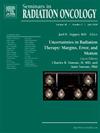Postoperative Radiation Therapy and Controversies Regarding Hormonal Therapy in the Management of Prostate Cancer
IF 3.2
3区 医学
Q3 ONCOLOGY
引用次数: 0
Abstract
Biochemical recurrence (BCR) after radical prostatectomy (RP) remains a clinical challenge, with significant heterogeneity in outcomes and optimal management strategies. Salvage radiotherapy (sRT) is the standard approach, yet the role and duration of concurrent hormonal therapy (ADT) are still debated. Four key randomized controlled trials—RTOG 9601, GETUG-AFU 16, RTOG 0534 SPPORT, and RADICALS-HD—have explored the addition of ADT to sRT. While ADT consistently improved progression-free survival metastasis-free survival (MFS) benefit was not consistently observed, and overall survival (OS) gains were limited and primarily confined to patients with higher pre-sRT PSA levels (>0.6-0.7 ng/mL). Toxicity associated with long-term ADT, including metabolic and cardiovascular effects, underscores the importance of patient selection. Emerging tools such as PSMA PET/CT and the Decipher genomic classifier show promise in refining risk stratification. PSMA PET/CT can identify occult metastases and guide treatment planning, while Decipher can help predict who may benefit from ADT. Retrospective and prospective data support their integration into clinical practice. Recent trials evaluating intensified systemic therapy with androgen receptor pathway inhibitors (ARPIs) in combination with sRT suggest potential benefit in high-risk BCR populations, although added toxicity remains a concern. The optimal role and timing of ARPIs in the early salvage setting require further investigation. In conclusion, the decision to add ADT to sRT in BCR patients should be individualized based on PSA kinetics, imaging, and genomic profiling. Shared decision-making and future biomarker-driven trials will be key to personalizing therapy and improving outcomes while minimizing harm.
前列腺癌术后放射治疗及激素治疗争议
根治性前列腺切除术(RP)后的生化复发(BCR)仍然是一个临床挑战,在结果和最佳管理策略方面存在显著的异质性。补救性放射治疗(sRT)是标准的方法,但同步激素治疗(ADT)的作用和持续时间仍有争议。四个关键的随机对照试验RTOG 9601、GETUG-AFU 16、RTOG 0534 SPPORT和radical - hd探讨了ADT在sRT中的添加。虽然ADT持续改善无进展生存期(MFS),但并没有一致观察到无转移生存期(MFS)的益处,而且总生存期(OS)的获益有限,主要局限于srt前PSA水平较高(0.6-0.7 ng/mL)的患者。与长期ADT相关的毒性,包括代谢和心血管影响,强调了患者选择的重要性。PSMA PET/CT和Decipher基因组分类器等新兴工具在细化风险分层方面表现出了希望。PSMA PET/CT可以识别隐匿性转移并指导治疗计划,而Decipher可以帮助预测谁可能从ADT中受益。回顾性和前瞻性数据支持其融入临床实践。最近评估雄激素受体途径抑制剂(arpi)联合sRT强化全身治疗的试验表明,尽管增加的毒性仍然是一个问题,但对高危BCR人群有潜在的益处。arpi在早期救助环境中的最佳作用和时机需要进一步研究。总之,BCR患者在sRT中加入ADT的决定应根据PSA动力学、影像学和基因组谱进行个体化。共享决策和未来生物标志物驱动的试验将是个性化治疗和改善结果的关键,同时将危害降到最低。
本文章由计算机程序翻译,如有差异,请以英文原文为准。
求助全文
约1分钟内获得全文
求助全文
来源期刊
CiteScore
5.80
自引率
0.00%
发文量
48
审稿时长
>12 weeks
期刊介绍:
Each issue of Seminars in Radiation Oncology is compiled by a guest editor to address a specific topic in the specialty, presenting definitive information on areas of rapid change and development. A significant number of articles report new scientific information. Topics covered include tumor biology, diagnosis, medical and surgical management of the patient, and new technologies.

 求助内容:
求助内容: 应助结果提醒方式:
应助结果提醒方式:


